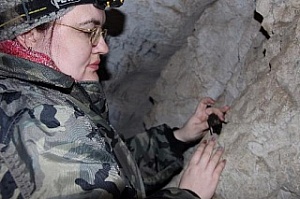Biologists from Russia and the Czech Republic are looking for reasons for the spread of the “white nose” fungus, which leads to the death of bats. Since 2006, several thousand colonies in North America have almost completely died out because of the syndrome that causes this fungus.
The white nose syndrome is caused by a fungus of the genus Geomyces: spores form a white coating on the muzzle and other parts of the body of bats, and damage appears on the skin. The causative agent of the syndrome is activated during hibernation, and beginning to multiply, it drains the animal and ultimately leads to its death.
Scientists already have found individuals infected with this fungus in Europe, but cases of mass mortality of bats from the white nose syndrome have not been recorded yet. However, due to the situation in the USA and Canada where nearly six million bats died, the study of the white nose syndrome is a priority area. Researchers are studying reasons for the spread of the fungus and the conditions of its development, in order to prevent the emergence of an epidemic in Europe.
In April this year, biologists from Tomsk State University, Ural State Medical University, the Institute of Vertebrate Biology of the Academy of Sciences of the Czech Republic, and the University of Veterinary and Pharmaceutical Sciences (Brno, Czech Republic) had a joint expedition. Scientists visited three caves near the city of Severouralsk (Sverdlovsk Region), where in 2014 infected individuals were found for the first time in Russia. To date, this is the most northern point where the white nose fungus was found.
- Previously, it was believed that that tourists carried the fungus into caves on the soles of their shoes. European colleagues suggested that ectoparasites, especially blood-sucking flies, can carry the fungus, - says Maria Orlova, senior researcher at the TSU Laboratory for Biodiversity Monitoring. - Parasitic arthropods often transmit pathogens of various diseases, but in the case of the white nose syndrome, there are peculiarities: the pathogen is the fungus, not the protozoa or the bacterium, and the spores are on the surface of the parasite.
To test the hypothesis, the researchers collected parasites in caves and collected samples of soil and walls, and in the near future researchers in the laboratory of the University of Veterinary and Pharmaceutical Sciences will extract fungal DNA for further study.
Next year, researchers plan to explore the cave where the northernmost colony of bats lives, Divya (Perm Krai).
In Russia, there are about 40 species of bats, and most of them are listed in the Red Book. Bats play an important role in agriculture, because they feed on pests. Because of the epidemic of the white nose syndrome in North America, 6 million bat individuals died in a decade, and every year American farmers lose about $3.7 billion.

